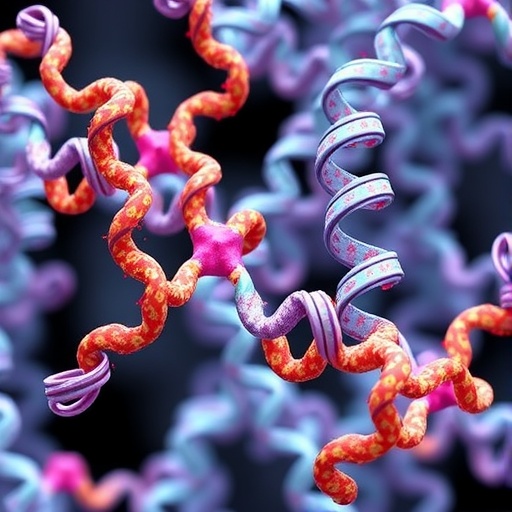In a revealing exploration of nitrogen fixation, one of nature’s most fascinating processes, researchers have focused their attention on the elusive nitrogenase enzyme complex, which plays a crucial role in converting atmospheric nitrogen into biologically accessible forms. The assembly of nitrogenase requires a delicate orchestration of molecular events, particularly the cooperation of various proteins within a multiprotein system to assemble its organometallic cofactor. Central to this assembly process is a scaffold protein known as NifEN, which orchestrates the final stages of cofactor biosynthesis before it can be integrated into the nitrogenase enzyme.
Recent advancements in structural biology have enabled high-resolution analyses of NifEN, unveiling its intricate workings as it facilitates the nitrogenase assembly process. Researchers carefully mapped the structural dynamics of this essential scaffold, illustrating how the cofactor precursor initially attaches to a designated surface docking site on NifEN. Understanding this initial docking phase is crucial, as it sets the stage for subsequent steps leading to the maturation of the cofactor itself, a complex process involving various organic and inorganic modifications.
Once the precursor is bound to the surface of NifEN, the magic truly begins. The studies reveal a fascinating transformation wherein the bound precursor is transferred into a specialized cavity within NifEN. This cavity serves not only as a holding chamber for further maturation but also as an area where diverse biochemical modifications can occur. What is particularly striking about these findings is the dynamic nature of the structural rearrangements that NifEN undergoes during this process.
Researchers observed that NifEN exhibits coordinated domain motions and can even partially unfold to accommodate the precursor and the necessary modifying components. This ability to shift between open and closed states is key to understanding how NifEN prepares the cofactor for its eventual role in nitrogen fixation. These dynamic motions suggest a sophisticated level of control over the coordination chemistry that is vital for the precursor’s transformation into its final functional form.
Interestingly, the research highlights a rear channel that extends from the precursor-binding cavity of NifEN. This channel is believed to facilitate the entry of modifying agents, specifically molybdenum, and homocitrate, that play a critical role in the transformation of the precursor into the activated cofactor. Molybdenum is essential for the catalytic function of nitrogenase, acting as a pivotal element in the conversion process. Meanwhile, homocitrate contributes to the structural integrity and stability of the final cofactor configuration.
With such finely tuned mechanisms at play, the study brings to light the vital distinction between the NifEN scaffold and the nitrogenase enzyme itself, represented by NifDK. While both components are essential for efficient nitrogen fixation, they serve distinctly different roles. NifEN’s primary responsibility is to act as the biosynthetic scaffold, ensuring that the assembly of the cofactor proceeds flawlessly, while NifDK represents the catalytic side, where the actual conversion of nitrogen occurs.
The implications of these findings extend beyond mere academic curiosity; they potentially pave the way for advances in agricultural biotechnology. By unraveling the underlying mechanisms of nitrogenase assembly, researchers may identify novel strategies to enhance nitrogen fixation in crops, ultimately leading to reduced reliance on chemical fertilizers. The ability to engineer or enhance the nitrogen-fixing capacity of plants could hold the key to fostering sustainable agricultural practices in an era increasingly challenged by climate change and resource scarcity.
Furthermore, this research highlights the importance of structural biology techniques, such as cryo-electron microscopy, that provide unprecedented insight into the molecular underpinnings of complex biochemical systems. As scientists continue to probe the structural features and dynamics of biological macromolecules, the potential for groundbreaking discoveries will only grow.
While the immediate focus has been on NifEN and its role in nitrogenase assembly, the broader implications of this research reach into multiple fields, including bioinorganic chemistry and molecular biology. As we deepen our understanding of how nature carries out such sophisticated processes, we can draw inspiration for biomimetic approaches that harness these principles for innovative applications.
This comprehensive understanding of the nitrogen-fixation mechanism not only paints a vivid picture of one of life’s essential processes but also showcases the elegance and complexity of molecular interactions within living systems. As researchers continue to delve into the nuances of nitrogenase function and assembly, the revelations promise to unlock further secrets of biological chemistry and guide future explorations in this vital area of study.
In conclusion, the research underscored the dynamic and multifaceted role of the NifEN scaffold in the intricate dance of nitrogenase cofactor assembly. Through high-resolution structural analysis, key insights were gained regarding the dynamics of precursor binding and processing within the scaffold. These findings not only advance our understanding of nitrogen fixation but also bear significant potential for impacting agricultural practices and biotechnological innovations in the coming years.
Subject of Research: Nitrogenase cofactor assembly and the role of NifEN scaffold.
Article Title: Dynamics driving the precursor in NifEN scaffold during nitrogenase FeMo-cofactor assembly.
Article References: Payá Tormo, L., Nguyen, TQ., Fyfe, C. et al. Dynamics driving the precursor in NifEN scaffold during nitrogenase FeMo-cofactor assembly. Nat Chem Biol (2025). https://doi.org/10.1038/s41589-025-02070-4
Image Credits: AI Generated
DOI: https://doi.org/10.1038/s41589-025-02070-4
Keywords: Nitrogen fixation, nitrogenase, NifEN, cofactor assembly, structural biology, sustainable agriculture, biomimetic approaches.
Tags: biological nitrogen fixation researchcofactor maturation processesdocking phase in nitrogenase assemblyhigh-resolution NifEN structural analysesmolecular events in nitrogenase functionmultiprotein interactions in nitrogenaseNifEN scaffold protein dynamicsnitrogen fixation mechanismsnitrogenase enzyme complex assemblyorganometallic cofactor biosynthesisprotein cooperation in enzymatic assemblystructural biology of nitrogenase assembly





